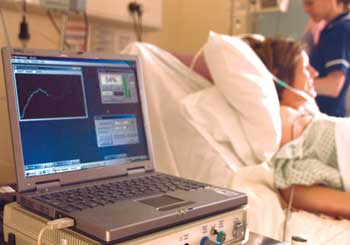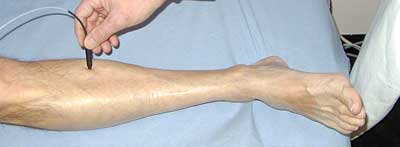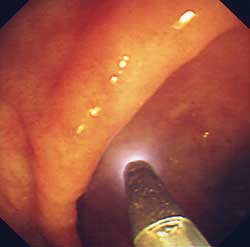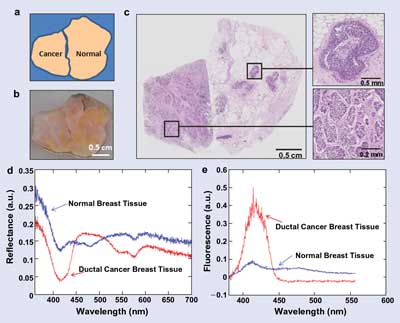Noninvasive spectroscopy is aiding clinicians in the treatment of brain trauma, cancer and more.
Measuring the amount of oxygen in blood carried by veins, arteries and even capillaries is a common diagnostic technique in hospital labs around the globe. It is critical in caring for brain trauma and stroke patients, because directing the right amount of oxygen to the brain is critical. Spectroscopic tools and techniques allow the task to be performed noninvasively, a more recent development that is gaining more utility as clinicians become more accustomed to these methods.

Monitoring tissue oxygenation helps track the progress of a surgical
procedure in which abdominal tissue replaces a breast removed via
mastectomy. Images courtesy of David K. Harrison, Institute of Cellular
Medicine, Newcastle University, UK.
Proponents of two types of spectroscopic methods for determining blood oxygenation share their views on the current state of the art as well as its future: David K. Harrison, honorary senior lecturer in medical physics at the Institute of Cellular Medicine, Newcastle University, UK, and Clare E. Elwell, professor of medical physics at University College London.
Why focus on visible-wavelength lightguide spectroscopy (VLS) and near-IR spectroscopy, respectively, for measuring tissue oxygenation?
Harrison: VLS has the advantage that the path length of visible light is much shorter [than] that of near-IR light, so the catchment volume is much more defined. However, this limits applications to surface or endoscopically guided measurements. A further advantage is that algorithms for quantification of hemoglobin saturation (SO2) are much easier to develop than for near-IR due to the presence of five isosbestic points in the Hb/HbO2 absorption spectra.
Elwell: The development of near-IR spectroscopy as a brain-imaging technology has found widespread application, especially where techniques such as magnetic resonance imaging are not appropriate – for example, with infants, the elderly or any patients who can’t easily be transferred to a scanner. Near-IR is more flexible and adaptable and is nonionizing to boot.

Hemoglobin can be measured along the leg during amputation level assessment.
Which spectra are of interest?
Elwell: The abundance of oxy- and deoxyhemoglobin make them excellent choices for monitoring blood flow in cerebral tissue. The relative proportion of oxy and deoxy – as well as the total amount of both – are key indicators of oxygenation and blood volume, but no single marker tells the whole story.
Harrison: Hemoglobin (Hb and HbO2).
Is VLS more useful for particular types of tissue or afflictions?
Harrison: The technique has been particularly successful in predicting healing viability in lower limb amputation for critical limb ischemia. It has also proved to be very useful in monitoring transverse rectus abdominis myocutaneous flaps during the first 72 hours following transplantation, when the viability may be at risk due to a blockage of the artery or vein. This is a plastic surgical procedure whereby abdominal tissue is transplanted to replace a breast that has had to be removed by mastectomy. A further successful application has been in monitoring the “vascularity” (blood flow and oxygen supply) in the colostomy stoma. This has been used to monitor the effects of different colostomy devices and products over months and even years, in some cases.
How do oxygen readings in one part of the body differ from another?
Harrison: Tissue oxygen saturation (SO2) depends on oxygen delivery and consumption, and these depend on the physiological/pathophysiological conditions under which the measurements are made. Since the SO2 is related to the tissue oxygen concentration (pO2) via the oxygen dissociation curve, for similar conditions of pH, pCO2 and temperature, the tongue and colon will show similar levels of SO2.
What issues remain?
Elwell: The origin of frequency oscillations in hemodynamics is not well understood, but they could provide information on regulatory processes in the brain. For example, we have recently identified these oscillations in adult patients with cerebral malaria and in children undergoing life support in cardiothoracic intensive care. The high temporal resolution of our technology has opened up new realms of research.
Harrison: The issue of diurnal variations was unclear due to the small sample size. Since then, it has become clear from studies on the colostomy stoma that the SO2 is approximately 3.5 percent higher later on in the day than it is in the morning. However, this small difference is not of any clinical significance. We have also observed, anecdotally, that smoking causes a significant decrease in SO2 in the mucosa (colostomy stoma). This could be one area for a more systematic study.
What other applications have you explored?
Harrison: The “driver” for my clinical research was originally the field of peripheral vascular disease – in particular, amputation level viability in critical limb ischemia. In the past, I have looked at a number of methods, including transcutaneous pO2 and pH2 electrode techniques and thermographic imaging. VLS has proved to be the quickest and most reliable method for predicting whether a below-knee amputation will heal.
We also have used both VLS and near-IR spectroscopy to measure oxygen saturation in the vicinity of abdominal wounds to investigate whether postoperative oxygen levels were predictive of surgical site infections developing later on. It transpired that, in this instance, the near-IR method was more accurately predictive of infections.
What technological advances are needed?
Elwell: I would like to see more-flexible laser sources, with more than a couple of wavelength choices employed in commercial systems.
Harrison: My greatest disappointment is the lack of wider uptake of the amputation viability application, where it can be of great benefit in maintaining patient mobility (maintaining the knee joint) whilst not putting the patient at risk of having to undergo further amputations because the first did not heal.

Measuring hemoglobin within the colon can be performed during endoscopy.
There is certainly further scope for gastrointestinal applications in the future. The use of the technique for monitoring trauma or shock patients could also be beneficial. Of course, oxygen saturation imaging would be a logical development in the field, and a number of clinical research applications of hyperspectral hemoglobin oxygenation imaging have been reported.
What is next for research in this area?
Elwell: The big area developing over the next 10 years is ambulatory monitoring. The standard system takes the space of a microwave oven, but shrinkage is happening now. For example, one group has devised oxygen monitors that speed skaters can wear while on the ice track; Bluetooth technology sends the data to a centralized computer on the fly.
Harrison: I am involved in a study in collaboration with the University of the West Indies in Barbados, looking at amputation level viability prediction. There is a huge problem with diabetes amongst the Caribbean population, and the development of a less expensive spectrophotometer for use in amputation level viability assessment could be of great human benefit in preventing unnecessary above-knee amputations, thus allowing patients to remain mobile.
Analyzing Tumor Margins
Blood is not the clinical spectroscopist’s only possible target, of course. Cancerous tumors set for resection must be removed as cleanly as possible, but visually inspecting and palpating the remaining tissue to determine its relative health is the current default method. That method provides only uncertain results – and, more importantly, is typically done well after the patient has left the surgical environs.
Getting a more reliable reading is important, but getting it quickly enough that it can be acted upon during the original resection would save time, money and lives.
The need to ensure both speed and accuracy has led many researchers to look to spectroscopic techniques as a way to analyze tumor margins on the fly.
“In vivo imaging strategies were proposed as potential tools for surgical margin assessment over a decade ago, [but] there continues to exist a significant clinical need for rapid and reliable evaluation of excised tissues in reasonable time,” said Niyom Lue, a research specialist at the George R. Harrison Spectroscopy Laboratory at MIT in Cambridge.
To develop a technique that can take a wide view of even large resections and yet is still highly accurate, Lue and his colleagues at MIT and at Case Western Reserve University in Cleveland and at Canon USA Inc. in Tucson, Ariz., looked to optical fiber-based scanner technology.

Breast cancer samples can be analyzed via diffuse reflectance spectroscopy (DRS) and intrinsic fluorescence spectroscopy (IFS): a) gross photograph of breast tissues; b) composite micrograph shows histopathology of tissues; c) (top) ductal carcinoma in situ, (bottom) invasive ductal carcinoma; d) DRS and e) IFS spectra of the breast tissues. Courtesy of Niyom Lue. From: “Portable optical fiber probe-based spectroscopic scanner for rapid cancer diagnosis: A new tool for intraoperative margin assessment,” PloS One, Vol. 7, No. 1, e30887, Jan. 27, 2012.
Probe-based diffuse reflectance spectroscopy (DRS) and intrinsic fluorescence spectroscopy are quantitative approaches that remove the interpretational aspects of the clinician’s job, Lue said. But just touching the end of a probe to a tissue section doesn’t work because that images only a small section; covering more ground equals wasted time with the patient under anesthesia.
Lue’s group developed a tissue scanner that can image an area up to 20 cm2 at a resolution of 0.25 mm. The system comprises two optical fiber bundles, one capturing DRS data and the other, fluorescence. The collected spectra are analyzed by a miniature spectrometer made by Ocean Optics Inc. of Dunedin, Fla.
The DRS-supplied spectra provide information about absorbers such as hemoglobin and beta-carotene, as well as light scatterers; intrinsic fluorescence, unaffected by tissue scattering and absorption, provides relative contributions of endogenous tissue fluorophores such as collagen.
“These combined parameters enable integration of different optical modalities to provide quantitative tissue information that correlates to disease state of the surrounding tissue,” Lue said.